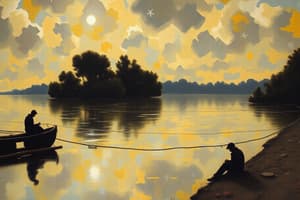Podcast
Questions and Answers
What is the Hawthorne effect?
What is the Hawthorne effect?
- The phenomenon where people act differently once they start to be observed, behaving in a way they think the observer wants them to see (correct)
- The correlation between two variables such as shoe size and height
- The limited sample size and low generalizability of case studies
- The loss of spontaneity in a contained environment during laboratory observations
Which of the following best describes a positive correlation?
Which of the following best describes a positive correlation?
- A correlation that just happened without any meaningful connection
- An increase in one variable and decrease in another
- As one variable goes up, the other does too, shown as a line going straight up on a graph (correct)
- The phenomenon where people act differently once they start to be observed, behaving in a way they think the observer wants them to see
Which of the following is an example of a negative correlation?
Which of the following is an example of a negative correlation?
- Happiness and helpfulness
- Reading correlation graphs
- An increase in one variable and decrease in another (correct)
- People acting differently once they start to be observed
What does the coefficient (r) in correlation studies indicate?
What does the coefficient (r) in correlation studies indicate?
Why are correlation studies used?
Why are correlation studies used?
What is the main difference between naturalistic and laboratory observations?
What is the main difference between naturalistic and laboratory observations?
When is it appropriate to use a case study?
When is it appropriate to use a case study?
How can observer bias be minimized in descriptive methods like naturalistic and laboratory observations?
How can observer bias be minimized in descriptive methods like naturalistic and laboratory observations?
What were the limitations of Genie's case study?
What were the limitations of Genie's case study?
In which type of observation method might the observer organize people to come to a specific setting and watch them from behind a two-sided mirror?
In which type of observation method might the observer organize people to come to a specific setting and watch them from behind a two-sided mirror?




